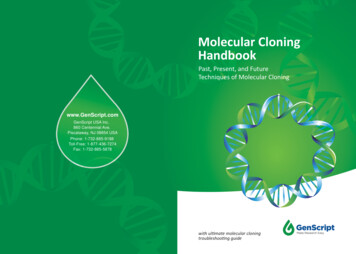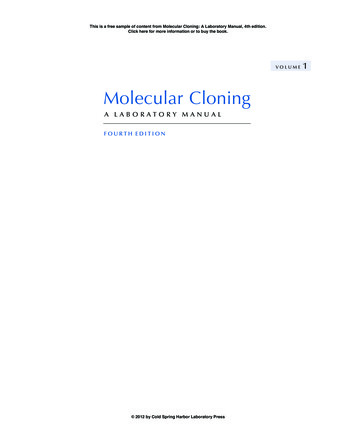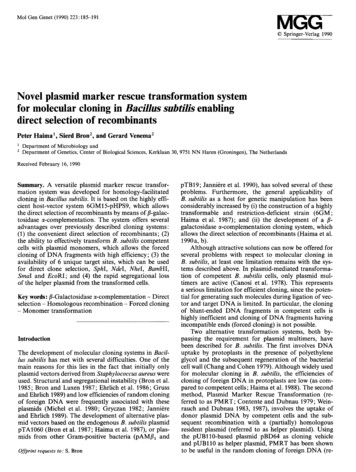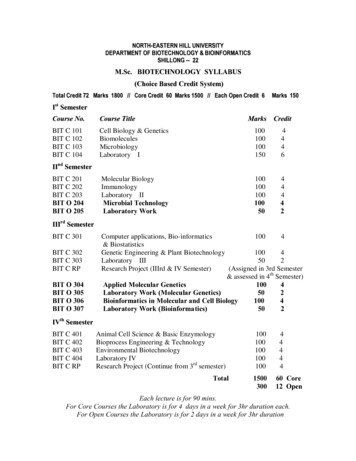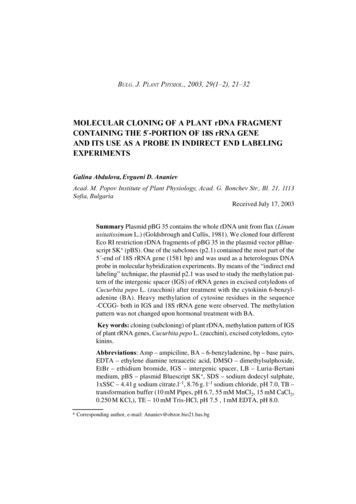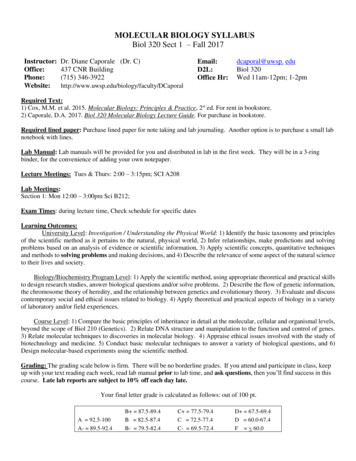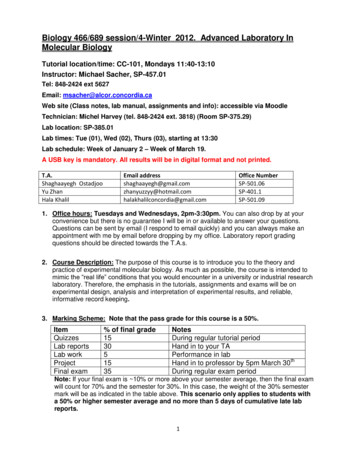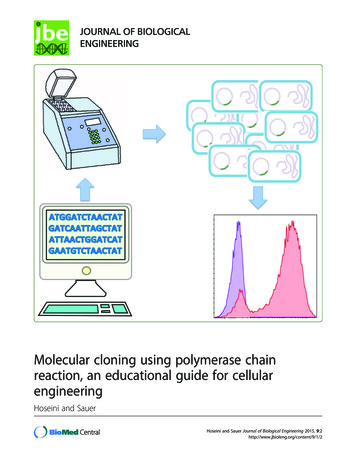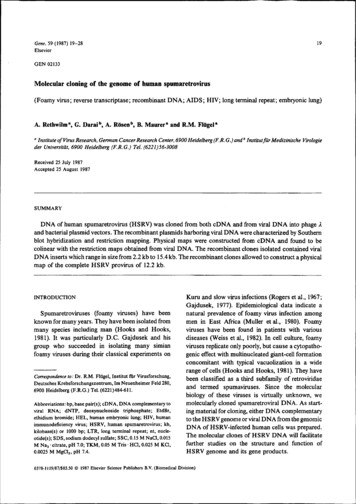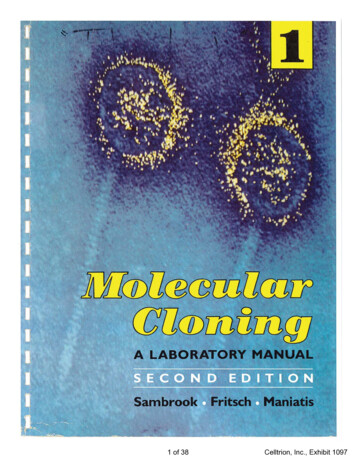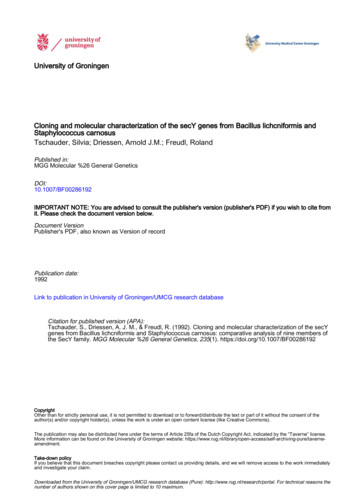
Transcription
University of GroningenCloning and molecular characterization of the secY genes from Bacillus lichcniformis andStaphylococcus carnosusTschauder, Silvia; Driessen, Arnold J.M.; Freudl, RolandPublished in:MGG Molecular %26 General GeneticsDOI:10.1007/BF00286192IMPORTANT NOTE: You are advised to consult the publisher's version (publisher's PDF) if you wish to cite fromit. Please check the document version below.Document VersionPublisher's PDF, also known as Version of recordPublication date:1992Link to publication in University of Groningen/UMCG research databaseCitation for published version (APA):Tschauder, S., Driessen, A. J. M., & Freudl, R. (1992). Cloning and molecular characterization of the secYgenes from Bacillus lichcniformis and Staphylococcus carnosus: comparative analysis of nine members ofthe SecY family. MGG Molecular %26 General Genetics, 235(1). https://doi.org/10.1007/BF00286192CopyrightOther than for strictly personal use, it is not permitted to download or to forward/distribute the text or part of it without the consent of theauthor(s) and/or copyright holder(s), unless the work is under an open content license (like Creative Commons).The publication may also be distributed here under the terms of Article 25fa of the Dutch Copyright Act, indicated by the “Taverne” license.More information can be found on the University of Groningen website: ing-pure/taverneamendment.Take-down policyIf you believe that this document breaches copyright please contact us providing details, and we will remove access to the work immediatelyand investigate your claim.Downloaded from the University of Groningen/UMCG research database (Pure): http://www.rug.nl/research/portal. For technical reasons thenumber of authors shown on this cover page is limited to 10 maximum.
Mol Gen Genet (1992) 235:147-152 Springer-Verlag 1992Cloning and molecular characterization of the s e c genesfrom Bacillus lichcniformis and Staphylococcus carnosus:comparative analysis of nine members of the SecY familySilvia Tschauder 1, Arnold J . M . Driessen 2, and Roland Freudl 11 Institut f/Jr Biotechnologie 1, Forschungszentrum Jtilich GmbH, Postfach 1913, W-5170 Jiilich, FRGa Department of Microbiology, Center of Biological Sciences, Kerklaan 30, NL-9751 NN Harem The NetherlandsReceived January 31, 1992 / Accepted April 27, 1992Summary. SecY is a central component of the exportmachinery that mediates the translocation of secretoryproteins across the plasma membrane of Escherichia coilWe have cloned and sequenced the secY genes fromBacillus licheniformis and Staphylococcus carnosus. Thededuced amino acid sequences are highly homologous tothose of other known SecY polypeptides, all having thepotential to form 10 transmembrane segments. Comparative analysis of 9 SecY polypeptides, derived fromdifferent bacteria, revealed that 14 amino acid positions(2,7%) are identical in all SecY proteins and 89 (16.9%)show conservative changes. Clusters of conserved aminoacid residues were found in 4 of the 10 transmembranesegments and 2 of the 6 cytoplasmic domains. It is suggested that the conserved regions might be involved inthe translocation activity of SecY or might be requiredfor the correct interaction of SecY with other components of the secretion apparatus.Key words: Gram-positive bacteria - Protein secretion M e m b r a n e protein - SecY - Nucleotide sequenceIntroductionTogether with SecA (Oliver et al. 1990), SecB (Kumamoto et al. 1989), SecE (Riggs et al. 1988; Schatz et al. 1989),SecD and SecF (Gardel et al. 1987; 1990), the SecYprotein (Ito 1984) forms part of the translocation machinery which mediates the transport of proteins acrossthe cytoplasmic membrane of Escherichia coli (Wickneret al. 1991). Genetic (Bicker and Silhavy 1990) and biochemical (Nishiyama et al. 1991) analyses have shownthat the SecY protein has a central role in the secretorypathway and, together with the SecE protein, is sufficientto allow SecA-dependent translocation of precursor proteins in reconstituted systems (Brundage et al. 1990;Akimaru et al. 1991).Correspondence to: R. FreudlSecY is an integral protein of the E. coli plasma membrane which includes 10 transmembrane segments (Akiyama and Ito 1987). Mutations have been identified inthe secY gene (Cerretti et al. 1983) which result either indefective precursor translocation (Shiba et al. 1984; Babaet al. 1990; Ito et al. 1989) or suppress certain defects inthe signal sequence of exported proteins (Emr et al. 1981 ;Sako and Iino 1988; Sako 1991). Since these mutationshave been found in various regions of the see Y gene andbecause long-range conformational effects exerted bythese mutations cannot be ruled out, additional approaches to the elucidation of structure-function relationships in the SecY polypeptide would be desirable.In the case of outer membrane protein OmpA, thecomparative analysis of amino acid sequences of OmpAproteins, derived from various bacteria, has contributedsignificantly to the understanding of the structural organization of the OmpA protein in the outer membrane (Braunand Cole 1984) and has led to the identification of functional domains (Cole and Maldener 1986). Therefore, asimilar approach might be very useful for the characterization of the SecY protein at a molecular level. Genesthat code for proteins highly homologous to the E. coliSecY polypeptide have recently been identified in Bacillussubtilis (Suh et al. 1990; Nakamura et al. 1990), Lactococcus lactis (Koivula et al. 1991), Micrococcus luteus(Ohama et al. 1989), Mycoplasrna capricolum (Ohkuboet al. 1987), Cyanophora paradoxa (Michalowski et al.1990) and Methanococcus vannielii (Auer et al. 1991).Certain gram-positive bacteria are widely used for theindustrial production of extracellular enzymes (Priest1977). However, in comparison with the situation inE. coli much less is known about the export apparatusin these organisms (Freudl 1992). In this communication,we describe the cloning and nucleotide sequences of see Ygenes from the gram-positive bacteria Bacillus licheniJbrmis and Staphylococcus carnosus. Alignment of 9 different SecY polypeptides allowed the identification ofregions which have been highly conserved during evolution.
148MateriaLs and methodsBacterial strains, phages and media. Strains were grownin Luria broth (LB) or on Luria agar (Miller 1972)supplemented with 40 gg ampicillin/ml, 30 gg kanamycin/ml, 30 gg chloramphenicol/ml, 0,5 % (w/v) glucose, or1 mM isopropylthiogalactoside (IPTG), as required.B. licheniformis DSM13 (Smith et al. 1964), S. carnosusTM300 (Schleifer and Fischer 1982) and B. subtilisDB104 (Kawamura and Doi 1984) were used as sourcesfor the isolation of chromosomal DNA. Genomic libraries were constructed in the bacteriophage vector lambdagtll (Huynh et al. 1984) and plated onto E. coli Y1090cells (Young and Davis 1983).Plaque hybridization and Southern blottin9. A 1 kb SmaIEcoRV fragment of pST120 (Sub et al. 1990), whichcomprises almost the entire secY gene of B. subtilis, waslabeled with digoxigenin using a non-radioactive D N Alabeling and detection kit (Boehringer Mannheim) according to the instructions of the manufacturer. Plaquehybridization and Southern analysis were performed asdescribed previously (Overhoff et al. 1991).DNA techniques. Isolation of chromosomal DNA,preparation of plasmid and phage lambda D N A andother D N A techniques followed standard procedures(Maniatis et al. 1982). The genomic libraries were constructed by cloning 2-5 kb chromosomal D N A fragments, prepared by EcoRI digestion, in the EcoRI-digested bacteriophage vector lambda gtll. The ligationmixture was packaged in vitro (Hohn 1979) and usedto infect E. coli Y1090. From the isolated recombinantbacteriophages, EcoRI fragments of either 4.1 kb(B. licheniformis) or 2.9 kb (S. carnosus) were subclonedin the EeoRI-digested plasmid vector pBGS18 (Sprattet al. 1986), yielding pBL43 (containing the B. licheniformis sec Y gene) and pSC45 (containing the S. carnosussee Y gene). For D N A sequencing the chain terminationmethod (Sanger et al. 1977) was used.Computer analysis of sequence data. Nucleotide and amino acid sequences were analyzed with the PC/Gene software package (IntelliGenetics, Mountain View, Calif.).Alignment of the SecY amino acid sequences was doneusing the CLUSTAL program of Higgins and Sharp(1988).ResultsClonin 9 of D N A fragments from Bacillus licheniformisand Staphylococcus carnosus which hybridizeto the Bacillus subtilis secY 9eneChromosomal D N A from B. licheniformis and S. carnosus was analyzed by Southern hybridization using a1 kb SmaI-EcoRV fragment of pST120, which includesalmost the complete secY gene from B. subtilis (Suh et al.1990), as a probe. In the EcoRI digest of B. licheniformisFig. 1. Identification of sec Y inB. licheniformis and S. carnosusby Southern blotting. EcoRIdigested chromosomal DNAfrom B. subtilis DB104 (lane 2),B. licheniformis DSM 13 (lane 3),S. carnosus TM300 (lane 4), orplasmid pST120 (lane 1) wereelectrophoresed on a 0.7%agarose gel, blotted onto nitrocellulose filters and hybridizedwith the digoxigenin-labelled1 kb SmaI-EcoRV fragment ofpST120. Detection of reactivebands was by an enzymelinked immunoassay usinganti-digoxigenin antibody whichhas been conjugated to alkalinephosphatase. Numbers at theleft margin indicate the size(in kb) of the markers usedchromosomal DNA, a 4.1 kb fragment was detectedwhich hybridized to the B. subtilis secY gene. Likewise,a 2.9 kb fragment was detected in the EcoRI-digestedS. carnosus chromosomal D N A (Fig. 1). Therefore, forthe construction of suitable genomic libraries, chromosomal D N A from B. licheniformis and S. carnosus wasdigested with EcoRI, and D N A fragments, 2-5 kb in size,were isolated and ligated into the EcoRI-digested cloningvector lambda gtl 1. Several recombinant phages showing a positive signal in a plaque hybridization assay wereidentified in both the B. licheniformis and the S. carnosusgenomic libraries. The isolated phages contained EcoRIinserts of 4.1 kb (B. licheniformis) or 2.9 kb (S. carnosus)in size. Subcloning of the corresponding fragments in theplasmid vector pBGS18 (Spratt et al. 1986) resulted inplasmids pBL43 (containing the B. licheniformis D N Afragment) and pSC45 (containing the S. carnosus D N Afragment).Nucleotide sequences of the B. licheniformis andS. carnosus secY genesThe nucleotide sequence of a 1.65 kb D N A fragmentfrom pBL43, encompassing the B. licheniformis secYgene, is shown in Fig. 2. An open reading frame (ORF)of 1293 bp was detected, starting at position 221 (Fig. 2).A potential TTG start codon is preceded by a possibleribosome-binding site (GAGG; positions 208-211). InB. subtilis, the secY gene is part of the spc operon and ispreceded by the gene coding for ribosomal protein L15and followed by the adk gene (Suh et al. 1990; Nakamuraet al. 1990). The same genomic organization was foundfor the B. licheniformis sec Y gene. In this case also, thesecY gene is preceded by the gene coding for L15 andfollowed by adk. Since no potential promoter sequencescan be identified upstream of the B. licheniformis sec Y
149I02030405060c a a c cI c c c o Ic a c a ocI c c l O o TACTCCTGAAAV VNLDKLNSF AE GTE VTPERC T T C T T T T A G A A A C A G G T G T A A T C A G C A A G T T G A A A T C T G G A G T G A A A A T T C T T G G C G A C 120L LLE TGVI S KLKSG VKI LGDG G T A A A T T A G A A A A G A A A T T A A C T G T T A A A G C C A A T A A A T T C TC C G C T T C T G C T A A A C A AGKLE KKLT VK ANKFS AS AKQSocY VNLEQLNRFEEGTEVTPA T TT CGC T GGTC GCTG CGT ATCG TAA E LLIETGVVKNAKAGIKVLG G TTGATGCE A FIPVPHVNTEDAT GG GAGCACAC ATCK GGAHEVIT T T C T T- FE TI VSecY C G C G G CGG C GA C ACGC CGC C G 360SVLKAQ ATC TGAGCGTATTTG A CT CACATTT C CGG CATTGTTC CTTD QMS VF GI LNTFGGGALFNFCTCCATTCTTGCGA TCATGCCTTACATCAUAGCTTCTATCATCATCCA CTCCTSi LAMGI MpYI TASIII QLLGCAGAT A TTG CCG G TACCG TGGTCT GCA GTT TCGCCGQ MD VVp KFTE WS KQGGRRALG120iNG o%L1802,0CT CGTCTC CGTTCATTCC CCGCACGT CACAGR GTTTT CACAF L oIQFFKTATT T TA Ti FKIGKEVRNKIF LA240300M VACTT ATATAC CTGCGCCTGG AGTC TCC AGC CA AT CTyI p AP GVNP TTTGGTGGCGGAGCCTTGAAGN Q GS QGVTDL LNTF GGGALK420480AACTTTTCCATATTTGCAA GGGTATCATGCCCTACATCACTGCTTCAATCGTAATGCAGNFSI F AMGI MPYI T ASI V MQ480540TTATTGC AAATC TATTGTTCCGAAATTTAC AGAATGGGCTAAACAC-GGTGATGTTGGALL QMDI VPKF TE WAKQ GDVG540600CGTAAGAAATTAAATAACGTTAC AC GTTAT TT TGC GATTATCTTAGCGTTTATCCAATCCR KKLNN VTRYF AII LAFI QS600TATGTCTTACGGGTT TAAC AACATGGCCGGCC GCGCGTTGATTACAGACCCGGGA.GTCGG 660MSyGFNNMAGGALI TDP G VGATCGGTATGGCATTC CAGTTTAATAAC TATTTGAAGGGCGC ATTGATTATTGATC CTTCTI GMAFQFNNYLK GALII DPS660TACTTATTT GTyLLI AI VLTAGTAFL CATTCTTATTATGGP MS YLLI AI VL TT GT AFLL W720A G A A C A A A T T A C G T C T C A T G G A G T T G G T A A C G G A A T A T C C A T T A T C A T C T T C G C C G G T A T 780E Qi TSH GVGNGI SIII F AGITTAGGTGAACAAATCACTCAGTATGGTG TAGGTAATGG TATTTCAATC ATTAT CTTTGC TL GE QI TQY G VGNGI 31II F A780CGTTGCCGGTATTCCGC AGACGATTAATCAGATC T ACGCTCAC CAGTTTGTAGATGCTGG 840VAGI pQTI NQI Y AQQF VD AGGGTATTTTGTCAACATTGCCATC ATCGCT TATTCAGTTTTATCAACAAGCC TTTGTCGGG 840GI LS TLPSSLI QFyQQAF VGAGATCAGTTATTC TTG CAAATCATAAAGGT TG TCGTTATATTGG TTGCGATTTTAGCGAT 900D QLFLQII K VV VI LVAI AAAATCTCAATTCAATATGCGAAVVG VI FI QQAVRKI SI QY CTACACACTTGCCGCTGAAGGTTAAGS GRSPV P G CAACGTATTTGCCGTTAAAAGTTAACKKQSTQRL GS N ATyLPLK CCACTCCGCGGACCGTP A G VI P VI F A V AFI TT " R T V1080TCAGCAC S AGVI P VI F AMAFF LLPRT1080GGCAAC ATTC TTTGGC TC CAATGAC GTCACGAATTGGATTCAA CATFF GSNDVTNWI QKGTTTGATTACACFDyT1140A C A A T G T T C T T C C C T A A A G C A G A T T G G G C TC A G C A A A T T G C T A A T A C A G C C A A T C C A T C A 1 1 4 0T MFFPK A0 W AQQI TTTACCTATTTCTATGCHP VGMGVY AALI AFT yFY A120012ooATT TGTG CAGGTTAAC C CTGAG CAAATGG CCGATAATC TTAAAAAACAAGGTGGC TATATF VQ VNPE QMADNLKKO GGY ATTTTGTATCGACTP GVRPGK MTQD RI TSI LyRL1320TACATTTGTAGGCTC CATATTC TTGGCCGTGATTGCCATTCTTCC TGTC TTGTTCGTTAATF VGSi FL AVI AI LpVLF VN1380EV CTAGCTCAGTTCAC TACTTCACGATCGTTCTTGGATTTATCCAGGC TAGGKL AQFTRyF TI VL GFI QTTATTGCTGGGC TGCCTTCTTCTGCACAAATTGGTGGAACAAGTTTGCTGATTGTCATCGGI AGLPSS AQI GGTSLLI VI GGGTTGCAC TTGAAAC TGAAGCV ALET MK720L1440AGCTTGAAAGC CAGCTC TAAAACGAAACTATCGTGG1500QLESQL VKRNyRGATTTATGAAG CAC TAGAGGAAATGGGGCGC GCC CATTC CC TC TA TAGAGAGGACF TA GC ACACAGGCTMNLDL MGLP GA GK GTQ AQSTDMTGSAMVAYWVLLQQVAAVGRLKVIIpGILQVy900L960ALT T T G T TC A A G T T A A T C C T G A A A A A A T G T C T G A C A A C C T T A A G A A A A G G C A G T T A C G T TF VQ VNPE K MSD NLKK QGSy V1260CCAGGT ATT A1320P G I R P G E Q T K K Y I T K V L Y R TF VGSI F LAVI AI LpITAGCTACTAAGL ATK1380TTTATGAACTTAC CGCAGTCAATCCAAGTCGGCGGTACAAGCTTATTAATCGTTATCGGTF MNLPQSI Q VGGTS LLI VI G1440GTTGCAATCGAAACGATGAAGAG TTTGG AAG CGC AAGTTAAC CAAAAAGAATATAAAGGCVAI E T MKS LE AQ VNQKEy KG15001560T T T G G T G G T A G A T A A A C T G T A G G A G G G CAAq'ATGAATATCATC T T A A T G G G T T T A C C T G G 1560F GGRMNII LMGLp TATTCAGK GTQ ASEI VKKFpICGCATATATC 1620pHI SGAACGGATTGTTGAAGATTTTE RI VEDFTACAGGTGATATGTTTATAAAAGCTATC AAATGD MFI KAI KPig. 2. Nucleotide and predicted amino acid sequences of a 1.64 kbDNA fragment from the B. licheniformissecYregion. Nucleotidesare numbered from the 5' end. The putative ribosome-binding sitefor the secYgeneisunderlinedFig. 3. Nucleotide and predicted amino acid sequences of a 1.65 kbDNA fragment from the S. carnosus secYregion. Nucleotidesarenumbered from the 5" end. The putative ribosome-binding site forthe secYgeneis underlined
150BLBSSCLL,ECMCMLCPMVTMS iDIRNKi i .i ! ! i i i I ! PHVNTEVLKA . . . . . QDQMSVFGILNTFDIRNK! i i I i ! I# # i i PYVNAEALQA. . . . . QSQMGVFDLLNTFEVRNKi i i i#i I i i PGVNPAAFDNN----QGSQGVTDLLNTFMFFKTLKEAF. . . . . . . . . . . .KVK. . . . . . . . . . . . . . . . . . . . . . .DVRARi i I # P G V N V Q N L Q Q V . . . . . ADLPFLSMMNLVMAKQPGLDFQ.SAKGGLG. . . . . . . . . . . . . . . . . . .ELKRR ii I I i i #i i iPGIDAAVLAKLL--EQQRGTIIEMFNMFMVlKKPANKV. . . . . . . . . . . .DKKSTFKSSNKKKNPFKSSFLTKN-KDLIYRi I i#! I I# # i i PGV---TLDKRFATDSSRIQFFQLLSTLML-KAIARIV. . . . . . . . . . . .RTP. . . . . . . . . . . . . . . . . . . . . . .DLLRK i i# # ## B PVNKTFKQGEAKLKRTLQTLQSRELSEIRKR i i# i i i#i#i # ii iPGTALNFDLESFQQNNSRNELANILNLL KIKPI . . . . . . . . . . . LELIPEVKRPLKGVS. . . . . . . . . . . . . . . . .FKEKi i# .# i i #! i . . . . . . . . . . . YMGGAEMPAMFAFWQTVM-FKTISNFM. . . . . . . . . . . . RVK. . . . . . . . . . . . . . . . . . . . . . .M-FKTISNFM. . . . . . . . . . . . RVS. . . . . . . . . . . . . . . . . . . . . . .M-FETIVNFF. . . . . . . . . . . . KTK. . . . . . . . . . . . . . . . . . . . . . .SS STMS 2BLBSSCLLECMCMECPMVGGGALFNFSi iiGGGALYQFSi IGGGALKNFSi.SGNAMQNSSiSGGALSRAS!IGGGSIGRFSiiSGGAL QVS !SGGAFLEIG TASKMG--T iSSS SBLBSscLLEC.CMLcP i .'. Mv QSMDVVPKFTEWSKQGE-VGRRKL A Q F T R i i i i - i NMA. . . . . . GGA-LI TDPGVG i i # Q M D V V PKFTEWSKQGE- VGRRKLAQFT R # I - i Nka . . . . . . NGM-LIEKSGVG QMDI VPKFTEWAKQGD-VGRKKLN N V T R # - N Y L . . . . . . KGA-LI I D P S P QMDI LPKFVEWSKQGE-I GRRKLN Q A T R # # B- AMS . . . . . . SEN-IVQNPNWQ # TV-VHPTLAEI KKEGE-SGRRKI S Q Y T R # # - NMP . . . . . . GMQGLVlNPGFA## #i # STDVI PVLTRWSKSGE-RGRKKLDKL T K # # - SQGL I I PGWDNTNAI ANS A F - :. . RV-VI P R F E Q L H Q E R R - R G Q A T L T Q Y T R - TGALLGCSLP---LLRDGS I L TK-ILPSLERFQKEQEDTAQREFKKWTR PYAL---NWD . FF VGSELISLDL. . . . S K P M N R A L F Q G L Q K 2 : 2 : : 3 - . . . . . . . . . . F G V V N S T sssTMS 5GEQITSH GEQITSH GEQI T Q Y GEQI N E K (. GEQITE : . A D Q I T I K GERI T E N AEQITEI D E I V S R . .g::: sssSSSTMS 3SSS F " ' g " E 140s . .U " ; ; . STMS 6QTINQIYA--QQFVD-AGDQLFLQIIK i i i i i i i i Q AVRKI SI QYAKKTIGQIYE--TQFVG-SNDQLFIHIVK i ! i Q A VRKI AI QYAKSSLI QFYQ--QAFVG-QSDTS-MAWLQ Q AVRKI PI QYAKSAIKSVYD--EKFLNVRPSEIPMSWIF [ Q A ERKVPI QYTKPAI ARTI E--QA---RQGDLHF - RGQRRI VVNYAK SNLKSTFEYWVSNSGEEANIFFS [[ E A E R K I PI Q-- Q GLGQVVQ. . . . . . . . . . . . . TQGWRV E S Q R RI PVQYAK N:SI EQLFN. . . . . . . SNI NWTFPMISS ESGRPVPVLI AR VGAFGAEGYLWKFFSAMSVGSLGIAFE. SI RVEI PLAHGRl L : ::" : :: :g" : :: :S . s.SS SS S248248247249250279244280240STMS 7TMS 8BL GSGRSPVPGGQST. . . . . . . . . HLPLKVNP i i i i i - i - ATFFGSNDVTN---WI---QKTFDYT-HPV - iBS GTGRSPAGGGQST. . . . . . . . . HLPLKVNP i i i i i i - - i ASFFGTNDVTN---WI---QNNFDNT-HPV !- i i - - SC KQSTQRL-GSNAT. . . . . . . . . YLPLKVN B i i i i - ! - TMFFPKADWAQ---QI - --ANTANPS-SNI B :; i- ilLL LTQGAPT. . . . SS. . . . . . . . . YLPLRVNP ! i i - LQF LQRSQGSNVG-WLSTLQNALSYT-T W T - IEC RQQGRRVYAAQST. . . . . . . . . HLPLKVN i ! i i - i - ASWFGGGTGWN---WLTTI SLYLQPG-Q P L - i - - : . MC TGSGLTDSSEHTP. . . . . . . . . YLPLKLNN i ! ! i ! - i-i i i SQI I EGVN-PDSG-FVI FTRDYLSFN-TWW - i i i iML RQIGSRTVGGSST. . . . . .---Y I P V K V N i i i i - I i i i I QFNTPQDGSAPAPWI TWLSRYFGSGDHPV . iCP QEAERQKFNEPI TEAERRKTQAYI FFQLLP ! i i i i .! FTNFL. . . . . LQQGNWGYQLIKSFPF--N S L iMV VKGAVGKYPIKFIYV. . . . . . SNLPVI L A I i L GQYSNGTAVSGI AYYFSTPYGI SNI I SDPLHA"i i :. . . SBLBSSCLL.ECMCMLCPMV . .TMS 9TMS 10 - QVNPEQMADNLKKQGGYIPGVR-PGKMTQDRITSILYR - ii i i i i I IQFAGLPQS I i i i i KQLESQLVKR - QVNPEKMSDNLKKQGSYVPGIR-PGEQTKKYITKVLYR - i ! T K F M N L P Q S ! i : . i K S L E A Q V N Q K -i QVNPEKMAENLQKQGSYIPSVR-PGKGTEKYVSRLLMR - i i i i QNVWGLPKI :. i i i I KQLEGYLLKR -I VFNPRETADNLKKSGAFVPGIR-PGEQTAKYIDKVMTR - I R D A M K V P - - i I i i i A Q V Q T L M M S S -! QINPEKIAENFQKSGTFIPGIK-PGKDTTKYLTGIINR i - ! i i S K L T Q L P S N i i ! I I Q Q L K G R I I Q Q cI ITFNPVEISDNMKRYGGFIPASA-PAGPTERYLQYVISR ! i i i F A V I G T S Q N i i K Q V S A Q M E Q R MINPKTLAENLNSMNALIPGVR-PGSETKVYSEQLIHR i i i I i I i E . G L P K L i I i I i R R . . S Y L G S S SGLDAKSMAKKLGNLDMAIKGFRKSQKSlEQRLKRYIKPi 2 i G . . . . . 2z i i i i iZ"Z2 -i EeLVeESSBLBSSCLLECMCMLCPMVSSSSS S SS SNY. . . . . . . . RGFMKH. . . . . . . . . .NY. . . . . . . . RGFMKN. . . . . . . . . .EY. . . . . . . . KGFGGR. . . . . . . . . .KY. . . . . . . . AGFMDNPLE---T--KQY. . . . . . . ESALKKANLK---GYGRNFIEK---KKEKFTNNINKNKTSHIWHY. . . . . . . . . . . . . . . . . . .EGLLRSPFKRDSSKREPLKRDFSKRRSA--NQLSELHPAVAK-FVGK. . . . . . . . . 5492437S SSS S SSS SSS SSS S S S424424422426427459428468421S S SFig. 4. Alignment of the SecY proteins from B. licheniformis (BL), S. carnosus (SC),B. subtilis (BS), L. lactis (LL), E. coli (EC), M. capricolum (MC), M. luteus (ML),C. paradoxa (CP) and M. vannielii (MV) using the CLUSTAL program of Higginsand Sharp (1988). 2.7% of the amino acid residues are identical (asterisks) and 16.9%represent conservative changes (s)gene, it seems very likely that the s e e Y gene is transcribedfrom the s p e promoter.The nucleotide sequence o f the S. c a r n o s u s s e e Y region is shown in Fig. 3. An O R F o f 1290 bp, starting withan A T G codon at position 223, is preceded by a potentialribosome-binding site ( G A G G ; position 212-215). As inthe case o f B . l i c h e n i f o r m i s , the S. c a r n o s u s s e e Y gene isflanked by sequences coding for the homologues of theribosomal protein L15 and adenylate kinase. Here againno sequences which might constitute a potential promoter could be identified upstream of the S. c a r n o s u ss e e Y gene.
151Table 1. Degrees of relatedness of SecY proteins from .668.266.060.056.21BS84.0-75.369.265.065.6 6 6 . 8.350.6EC48.0 45.6I41.81 41.1! 41.238.0H 39.71 39.2! 39.839.033.0ilL37.638.338.633.738.425.9CP29.528.81 30.530.326.226.128.7ilV19.522.321.31 20.020.120.120,752.418.1Values below the diagonal represent percentage of identical aminoacid residues; values above the diagonal represent the percentageof identical plus chemically related amino acids. Species abbreviations as in Fig. 4Sequence alignment of a family of Sec Y proteinsThe SecY proteins of B. licheniformis (431 amino acidresidues) and S. carnosus (430 amino acid residues) showa high degree of similarity to the SecY polypeptides fromE. coli (Cerretti et al. 1983), B. subtilis (Suh et al. 1990;Nakamura et al. 1990), L. lactis (Koivula et al. 1991), M.luteus (Ohama et al. 1989), M. capricolum (Ohkubo et al.1987), C. paradoxa (Michalowski et al. 1990) and M.vannielii (Auer et al. 1991) (Table 1). The E. coli SecYprotein is thought to contain 10 transmembrane segments (TMS; Akiyama and Ito 1987). Prediction of thehydropathy profiles for the B. licheniformis and S. carnosus SecY proteins (not shown) and alignment of thesequences with those of other members from the SecYfamily indicated that the transmembrane topology mightbe the same for all SecY polypeptides (Fig. 4). Furthermore, the alignment of all 9 SecY proteins showed that,at the corresponding amino acid positions, 14 amino acidresidues (2.7%) are strictly conserved and 89 (16.9%)positions show conservative changes (Fig. 4). The mostconserved regions were found in TMS 2, 5, 9 and 10 andin the hydrophilic loops connecting TMS 4 with 5 andTMS 8 with 9. Interestingly, except for the secYlO0mutation, in which a glycine residue is changed toglutamic acid (Ito et al. 1989), none of the known secY/prlA mutations affects an amino acid residue that hasbeen highly conserved.DiscussionIn E. coli, the SecY protein is of crucial importance forthe translocation of secretory proteins across the cytoplasmic membrane (Ito et al. 1983) and, together with theSecE protein, forms part of the membrane-boundtranslocator complex (Bicker and Silhavy 1990; Brundage et al. 1990). However, the precise role of the SecYprotein in protein translocation at the molecular level iscompletely unknown. The comparative analysis of SecYproteins, derived from different bacteria, therefore represents a useful approach for the identification of functionally important regions. In this communication, wedescribe the cloning and nucleotide sequencing of thesee Y genes from the industrially important gram-positivebacteria B. lichen ormis and S. earnosus and the comparison of their deduced amino acid sequences with thoseof other proteins from the SecY family.As in the case of B. subtilis, the secY genes fromB. licheniformis and S. earnosus are located within theribosomal spc operon and are preceded by the genecoding for ribosomal protein L15 and followed by theadk gene (Sub et al. 1990; Nakamura et al. 1990). Sinceno obvious promoter sequences could be found upstreamof the see Y genes in either case, transcription of the sec Ygenes most probably occurs from the promoter of the spcoperon. The deduced amino acid sequences of the SecYproteins from B. lieheniformis and S. carnosus show substantial similarities to other SecY polypeptides. TheE. coli SecY protein is thought to span the cytoplasmicmembrane 10 times (Akiyama and Ito 1987). Analysis ofthe hydropathy profiles and alignment of all known SecYsequences reveal that this membrane topology may wellbe conserved in all SecY polypeptides examined so far.In all cases, 10 potential transmembrane segments couldbe identified. However, clusters of highly conserved amino acid residues are found in only four of the transmembrane segments (Fig. 4; TMS 2, 5, 9, 10). It is temptingto speculate that these regions might be directly involvedin the translocation activity or might be required for theproper interaction of SecY with other membrane components of the translocation apparatus. In addition, thehydrophilic loops connecting TMS 4 with 5 and TMS 8with 9, which, according to the topological model for theE. coli SecY polypeptide (Akiyama and Ito 1987), facethe cytosol, are remarkably conserved. Because SecA, aperipheral plasma membrane protein (Oliver et al. 1990)and SecY are thought to interact (Fandl et al. 1988; Hartlet al. 1990), these cytosolic loops could be domains whichare involved in SecA/SecY interaction. Except for onemutation (see YlO0), the E. coli secY/prlA mutationsisolated so far do not affect strictly conserved amino acidresidues. This might suggest that the conserved residuesare directly involved in the proper functioning of SecYas part of the protein translocator complex. Mutationswhich alter structurally or functionally important aminoacid residues might cause the complete loss of SecYfunction and, due to the essential nature of SecY activity(Ito et al. 1983; Nishiyama et al. 1991), would not havebeen recovered in the selection procedures used so far.Site-directed mutagenesis procedures may now be usedto test the involvement of the corresponding amino acidresidues in SecY function in a more direct manner.Acknowledgements. We are very grateful to C. Price for providingus with plasmid pST120. We thank H. Sahm for his continuoussupport and J. Carter-Sigglowfor critically reading the manuscript.This work was supported by a grant from the BMFT to S.T. andR.F.ReferencesAkimaru J, Matsuyama SI, Tokuda H, Mizushima S (1991) Reconstitution of a protein translocation system containing purifiedSecY, SecE, and SecA from Escherichia coli. Proc Natl Acad SciUSA 88 : 6545-5549Akiyama Y, Ito K (1987) Topology analysis of the SecY protein,an integral membrane protein involved in protein export inEscherichia coli. EMBO J 6:3465-3470
152Auer J, Spicker G, B6ck A (1991) Presence of a gene in the archaebacterium Methanococcus vannielii homologous to sec Y ofeubacteria. Biochimie 73 : 3465-3470Baba T, Jacq A, Brickman E, Beckwith J, Taura T, Ueguchi C,Akiyama Y, Ito K (t990) Characterization of cold-sensitivesecY mutants of Eseherichia coli. J Bacteriol 172:7005-7010Bicker KL, Silhavy TJ (1990) PrlA (SecY) and PrIG (SecE) interactdirectly and function sequentially during protein translocationin E. coli. Cell 61 : 833-842Braun G, Cole ST (1984) DNA sequence analysis of the Serratiamareeseens ompA gene: implications for the organization of anenterobacterial outer membrane protein. Mol Gen Genet195:321-328Brundage L, Hendrick JP, Schiebel E, Driessen AJM, Wickner W(1990) The purified E. coli integral membrane protein SecY/Eis sufficient for reconstitution of SecA-dependent precursor protein translocation. Cell 62:649-657Cerretti DP, Dean D, Davis GR, Bedwell DM, Nomura M (1983)The spc ribosomal protein operon of Escherichia coli: sequencean
Cloning and molecular characterization of the secY genes from Bacillus lichcniformis and Staphylococcus carnosus Tschauder, Silvia; Driessen, Arnold J.M.; Freudl, Roland . (Maniatis et al. 1982). The genomic libraries were con- structed by cloning 2-5 kb chromosomal DNA frag- ments, prepared by EcoRI digestion, in the EcoRI-digest- .
